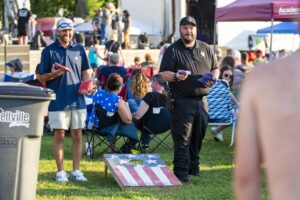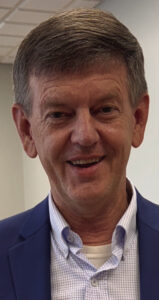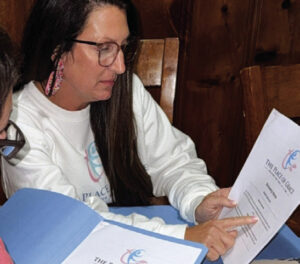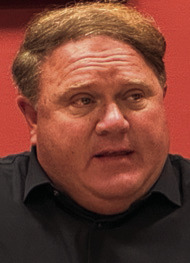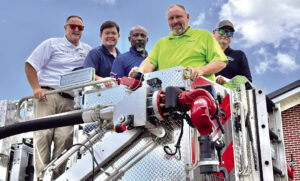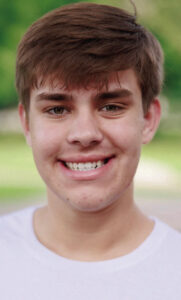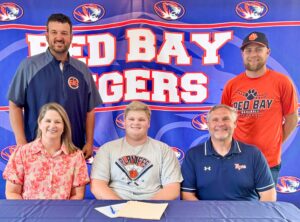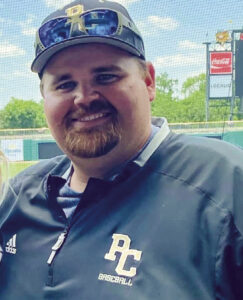From the country to the cosmos: How one Franklin County man found his place among the stars
FRANKLIN LIVING—
It was 1971. In downtown Corpus Christi, Texas, Keith Bates ducked into a newsstand, where newspapers from all over the country were for sale. “I bought every one I could get ahold of – Denver, Chicago, New York, Miami – and took them home and took the want ads out of them.” The recently-laid-off Bates scanned the job ads line by line and sent a resume to every likely option, more than a hundred, across the country.
Aluminum Smelters of New Jersey, a listing he found in the Philadelphia Inquirer, was the only job offer he got. So he and his wife Gail and their toddler son, Kevin, packed up and moved across the country for the new opportunity as supervisor in aluminum extrusion – a job that would be one in a succession propelling Bates into the national space program.
Bates’ story begins, of course, a little closer to home – in Pleasant Site, Franklin County, where he grew up. The Red Bay Class of 1965 alum said he was always mechanically-minded. He was working a pair of mules and driving a tractor to help with farm chores by the age of 12 or so, and by 15 he was working as a part-time auto mechanic and farmer. At that time he thought he would one day put his skills to work as a tool and die maker in the automotive industry. As it turns out, he could have set his sights a little higher, as his career would one day land him among the brightest engineering minds in the nation.
When Bates was a fresh-faced 18-year-old, he met the woman who would become his wife, Gail Rea. A mutual friend connected them, to facilitate a double date. “He says, when I walked into that living room, that he said to himself, “I’m going to marry her if there is any way in the world,’” said Gail, who also grew up in Franklin County, graduating from Belgreen in 1967. She didn’t share his immediate head-over-heels attraction, but eventually, she jokes, he wore her down. They married on Christmas Eve 1966.
Bates said he always had in mind that he would go to college, an ideal set forth by his parents. He started at the junior college in Phil Campbell, the first year the school had established a formal campus. It was the chemistry professor there, a graduate of Mississippi State, who convinced Bates to abandon his plan of majoring in mechanical engineering at the University of Alabama and instead enroll at Mississippi State to be part of the co-op program with Redstone Arsenal. His mentor on the Arsenal was John Honeycutt – a man who would turn out to be a crucial connection later in life.
After finishing his degree in materials engineering – which he chose simply because it aligned with the co-op program – Bates moved his family to Texas for a year. The Texas job ultimately laid him off, setting him on the path that would lead to the space program.
From Aluminum Smelters, Bates’ career progression carried his family to Wisconsin, where he worked in a similar role for Vulcan Materials; to Reynolds Metals Company, where he started as a metallurgist in Texas and Sheffield before rising to application engineer based in Virginia; and to Revere Copper and Brass in Scottsboro on Goose Pond Island, where he rose all the way to mill superintendent.
It was his next opportunity, however, that would prove to be the defining job change in Bates’ career.
It was 1983, and Bates’ mentor Honeycutt was still working on the Arsenal. A colleague at NASA contractor United Space Boosters Incorporated in Huntsville asked Honeycutt whether he might know someone with expertise in aluminum who would be interested in coming to work as an engineer on the solid rocket boosters for the space shuttle program – and Honeycutt knew the perfect man for the job. With Bates’ time at Revere coming to a close because of a plant shutdown, he was in need of a job, so the position at USBI came at the perfect time.
As he puts it in his resume, Bates “assumed increasing responsibilities,” rising from SRB senior materials engineer to chief of SRB Materials and Processes to manager of SRB M&P before transitioning to United Space Alliance in the same role, when USA – a joint venture of Boeing and Lockheed Martin – continued the SRB contract.
In early 1997, the Bates dropped their daughter Amy off at the University of Montevallo and headed to Cape Canaveral, Florida.
A job Bates thought he might hold for a couple of years had become a 14-year career – and it wasn’t over yet.
His wife remembers the moment Bates told her he thought he was in the running for United Space Alliance chief engineer. Of course, with a healthy dose of humility, Bates said he never thought he’d be selected. Nevertheless, in 2004 he found himself at the helm as SRB Chief Engineer, based at the Kennedy Space Center in Florida.
“It’s the ultimate dream job for an engineer,” Bates said. “You don’t have any personnel issues. We had hundreds of engineers and technicians working on the boosters, and every one of them reported to me, technically. I could tell any of them what they could do and what they couldn’t do, but they all had their own line of reporting.” With the personnel matters relegated to other managers, Bates in his role was able to focus on making unbiased and undistracted determinations about the readiness of the shuttles. “The chief engineer is ultimately responsible for making all technical decisions and taking the risks associated with those decisions, as to whether or not the vehicle is ready to fly – from the smallest to the biggest decision.”
Bates became chief engineer the year after the Space Shuttle Columbia disaster. “The first year, the only thing we did was try to get past Columbia. That wasn’t a booster problem, it was a tank problem, but we were all still dead in the water,” Bates explained. He had already been through the Challenger disaster of 1986 during his time at USBI and was involved in investigating the cause – for which he received a certificate of appreciation from then-NASA administrator James C. Fletcher. So recovering from a major shuttle disaster was, unfortunately, not a new experience.
During his first launch as chief engineer, in 2005, Bates’ 10-year-old grandson Austin was excited to watch the event on television – but probably no more excited than Bates himself. “We were hyped up then because we hadn’t flown in over two years,” Bates said.
From 2004-2008, Chief Engineer Bates was the point person for 10 launches. Out of the total 135 missions flown by space shuttles during the Space Transportation System’s 1981-2011 tenure, he was involved in 128 of them in some capacity.
Bates has many memories from his work as chief engineer. One that stands out happened one Saturday morning, when he was called in about 11 a.m. to assess the damage to a shuttle that had been struck by lightning the night before. The shuttle was on the pad, ready to launch, and the team needed Bates’ OK that it was cleared to fly.
“At 2 a.m., he still wasn’t home,” Gail said. “He had told me when he left, ‘I don’t know when I’ll ever be back.’ The only thing we had then were BlackBerrys, so we didn’t have texting, just email. He emailed me at 2 a.m. and said, ‘Pray for me. They are trying to make me sign off on this, and I’m not going to do it.’”
With no way to ensure the shuttle was undamaged, Bates had to stand his ground against colleagues who insisted it was fine. “He knew if he signed it, and that thing blew up, it would be his signature,” Gail explained. When another tropical storm blew in, requiring a delay to the launch, Bates and his team were able to take the time to check all the circuitry feeding into the systems and determine it was, indeed, OK. “We’ve never been so proud of a tropical storm before.”
In another incident, which Bates said was funny but required repair, one of the shuttles on the pad came under attack – by woodpeckers. “They were attacking the tank foam insulation. This foam is thick, and it has the texture of spray foam you would fill a hole in your house wall with. It’s real easy for woodpeckers to peck holes in … They were apparently making nests.”
In his capacity as chief engineer, Bates said, although he coordinated with the technical community, he was largely the final word for USA on the SRBs’ readiness for launch. It was a responsibility he shouldered with calm confidence. “They said the more complex the problem and the tougher it was, the calmer I got,” Bates said. “I’ve been told that. I don’t remember it that way, but I don’t remember being nervous or scared. This has always been my approach: Plan for the worst, hope for the best. I expect the worst is going to happen, but we’re going to get through it.”
Bates transitioned out of the chief engineer role to director of design engineering in 2008, which allowed him and Gail to move from Florida back home to Alabama, based in Huntsville. After more than 28 years in the shuttle program, he retired in 2011 – but that wouldn’t last long.
After dismantling and rebuilding a classic car and winning car shows, Bates was at a loss as to how else to pass his retirement years. That’s when another opportunity with the space program arose. With the bulk of his career based in materials and processes, Bates continues to lean on that experience as consultant to the SLS booster at NASA-MSFC, a role he has held since 2015.
“When offered the opportunity to return to work on a part-time basis,” Bates said, “of course, it took me a while to think it over. I really struggled over the decision – for about two seconds.” He was immediately on board, and the consultant job is one he continues in to this day.
Interestingly, another man from Pleasant Site, Jerry Smelser, was project manager for the space shuttle main engine and external tank areas at Marshall Space Flight Center around the same time as Bates, though they never crossed paths professionally. Bates said he has always been proud Pleasant Site boasts not one but two men who were instrumental in the space program.
Bates gets choked up when he reflects on the way the Lord directed his steps through life. “None of the decisions I made were really my own,” he said. “Back then, I was just trying to keep a job. It was rough in the early 70s. Looking back on it …there’s not any way I was smart enough to do all that. I’ve been blessed beyond any imagination.”


